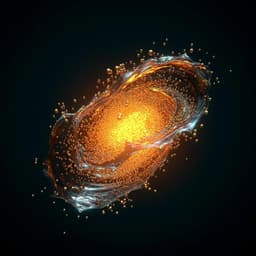
Chemistry
Extending density functional theory with near chemical accuracy beyond pure water
S. Song, S. Vuckovic, et al.
Discover groundbreaking research by Suhwan Song, Stefan Vuckovic, Youngsam Kim, Hayoung Yu, Eunji Sim, and Kieron Burke that enhances the SCAN approximation for accurate biosimulations of pure water and biomolecular interactions. This innovative HF-r²SCAN-DC4 method captures weak dispersion forces, crucial for understanding noncovalent interactions, improving the reliability of simulations in complex biological environments.
Playback language: English
Introduction
Water's unique properties and vital importance across various scientific fields have spurred the development of electronic structure methods for its simulation. While ab initio quantum-chemical methods are computationally expensive for large systems, Kohn-Sham density functional theory (KS-DFT) offers a balance between accuracy and computational cost. Historically, however, KS-DFT has struggled to achieve sufficient accuracy in water simulations to reproduce experimental data. A significant advancement by Dasgupta et al. demonstrated that the SCAN functional, combined with density-corrected DFT (DC-DFT), achieves near chemical accuracy for water simulations. This is a crucial step towards accurate biosimulations, as water's role in chemical and biochemical reactions extends beyond simply providing a solvent environment; it often participates directly in reaction mechanisms. The interaction between water and other molecules must be accurately described for a complete understanding of such reactions. This study aims to address the limitations of existing methods by developing a functional that maintains high accuracy for pure water while accurately capturing noncovalent interactions (NCIs), which are essential for describing interactions between biomolecules. The research focuses on extending the applicability of the successful density-corrected SCAN approach to encompass the vital role of dispersion forces in biomolecular systems.
Literature Review
The paper reviews existing literature on density functional theory (DFT) applications to water simulations, highlighting the limitations of traditional functionals in accurately reproducing experimental data. It emphasizes the recent breakthrough achieved by Dasgupta et al., showcasing the significant improvement in accuracy obtained by using the SCAN functional in conjunction with density-corrected DFT (DC-DFT) for pure water simulations. This review also points out the necessity of incorporating dispersion corrections to accurately model the non-covalent interactions ubiquitous in biomolecular systems, while noting the challenges associated with combining dispersion corrections with existing high-accuracy methods for water. Existing DFT methods are compared for the simulation of water, acknowledging the limitations of each approach and the need for a more comprehensive method.
Methodology
The study leverages the principles of density-corrected DFT (DC-DFT), a framework that separates errors in self-consistent DFT calculations into contributions from the approximate density and the approximate functional. The research employs the Hartree-Fock (HF)-DFT approach, where density functionals are evaluated using HF densities and orbitals, which has been shown to improve accuracy in cases where density-driven errors are significant. The SCAN meta-GGA functional, known for its accuracy but slow grid convergence, is addressed using the regularized-restored SCAN (r²SCAN) functional. To incorporate dispersion effects essential for noncovalent interactions, a dispersion correction (D4) is systematically applied. The key innovation lies in carefully parameterizing the D4 correction using DC-DFT principles, ensuring that the correction does not compromise the accuracy achieved for pure water simulations. The HF-r²SCAN-DC4 functional is obtained through a procedure that minimizes mean absolute errors (MAEs) over a selected set of density-insensitive reactions from the GMTKN55 dataset, using water-water pair interaction energies as a validation set. The methodology emphasizes the critical role of using only density-insensitive reactions in the parameter fitting process, which ensures that the parameters primarily optimize the true functional error rather than masking errors in density. The researchers carefully analyze the contribution of each component (HF density, r²SCAN functional, and D4 dispersion correction) to the overall accuracy, demonstrating that all three components are essential for the improved performance of HF-r²SCAN-DC4. Various datasets are employed to evaluate the accuracy of HF-r²SCAN-DC4 against other functionals, including water clusters (WATER27), water hexamers, water 20-mers, water-aspirin interactions from MD simulations, and a broad range of non-covalent interactions from the GMTKN55 database. The many-body expansion (MBE) is used to further analyze the accuracy of the interactions in water clusters, by examining the 2-body, 3-body, and higher-order contributions to the total interaction energy.
Key Findings
The study demonstrates that the newly developed HF-r²SCAN-DC4 functional significantly improves upon existing methods for simulating both pure water and systems involving water and other molecules. Specifically: (i) HF-r²SCAN-DC4 improves upon HF-SCAN for pure water simulations, enhancing the accuracy of relative energies for water hexamers (up to 0.7 kcal/mol) and water 20-mers (up to 2.4 kcal/mol). (ii) It is substantially more accurate than HF-SCAN for interactions between water and other molecules, as well as for general non-covalent interactions (NCIs), due to the inclusion of dispersion corrections. This improvement is exemplified by the significantly reduced errors in stacking interactions in nucleobases and interactions between water and aspirin, as observed in Molecular Dynamics (MD) simulations. (iii) Unlike HF-SCAN, HF-r²SCAN-DC4 overcomes grid convergence issues, making it more efficient for routine calculations. The analysis of the many-body interactions in water hexamers using the many-body expansion (MBE) reveals that the improvements of HF-r²SCAN-DC4 over HF-SCAN are systematic, not solely due to error cancellations between different contributions. Benchmarking against the GMTKN55 database, a standard benchmark for non-covalent interactions, confirms HF-r²SCAN-DC4's superior accuracy for a wide range of NCIs. The researchers showcase HF-r²SCAN-DC4's remarkable performance on the GMTKN55 database while simultaneously exhibiting improved accuracy for various water-related properties, highlighting its broad applicability. Comparisons to other popular functionals (such as ωB97M-V) reveal that HF-r²SCAN-DC4 strikes a balance between accuracy and computational cost, outperforming many standard functionals in terms of accuracy for water simulations while maintaining a lower computational cost. Analysis demonstrates the importance of each element of HF-r²SCAN-DC4: The HF component mitigates density-driven errors, r²SCAN addresses grid convergence issues, and the carefully parameterized D4 correction incorporates dispersion interactions without sacrificing accuracy for water.
Discussion
The results validate the effectiveness of the DC-DFT principles in developing accurate density functionals for water simulations. The superior performance of HF-r²SCAN-DC4 over HF-SCAN for both pure water and systems involving water and other molecules highlights the importance of incorporating both density corrections and dispersion corrections in a systematic manner. The carefully parameterized D4 correction is crucial for achieving this balance; alternative approaches, as demonstrated in comparing the results to those of ref. 64, can lead to inferior accuracy. The findings contribute significantly to the field of computational chemistry by providing a density functional that achieves near chemical accuracy for a wider range of chemical problems involving water, including the subtle energetics of water clusters and the complex NCIs in biological systems. This advancement makes accurate first-principles simulations of biomolecular systems in aqueous solutions more feasible.
Conclusion
This work presents HF-r²SCAN-DC4, a new density functional that significantly improves the accuracy of water simulations compared to previous state-of-the-art methods. This functional successfully combines the accuracy of density-corrected SCAN for pure water with the ability to model noncovalent interactions accurately, thanks to the carefully parameterized D4 dispersion correction applied within the framework of DC-DFT. Its enhanced accuracy and computational efficiency make it a promising tool for various applications, particularly in biomolecular simulations. Future research could explore further refinements of the D4 parameterization and the application of HF-r²SCAN-DC4 to even more complex biomolecular systems and larger-scale simulations.
Limitations
While HF-r²SCAN-DC4 demonstrates significant improvements, its accuracy might still be limited by the inherent approximations within DFT. The parameterization relies on a specific set of density-insensitive reactions from the GMTKN55 database. Extending the training set and exploring alternative parameterization strategies could further enhance the functional's generalizability. The computational cost, although lower than some higher-level methods, might still be prohibitive for extremely large systems. Future studies should investigate strategies for further improving computational efficiency without sacrificing accuracy.
Related Publications
Explore these studies to deepen your understanding of the subject.







